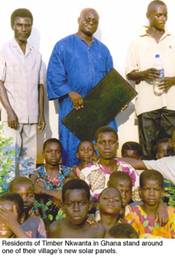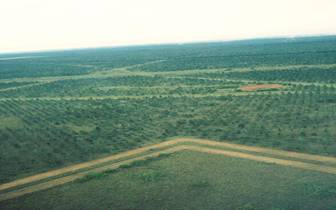|
This page was created by: Rey Medina & Leah Richter |

|
Current Applications |

|
Appropriate Technology
|
|
[6]Source: Thompson, Nicholas and Bayon, Ricardo. “Bright Lights, Small Villages” Washington Monthly.com. Issue: December 2002.
A small village in Africa named Patriensa is using technology to bring light to their villages. In a country with political turmoil and in financial poverty the use of grid power seems almost impossible for a small rural village like this. With the use of solar voltaic cells these problems are coped with. The government has installed solar power to villages like this for an associated fee to help pay for the cost of this expensive technology. Keep in mind that there is a big income gap compared the living that the mass people share in first world countries.
Some positive results from this type of outreach would be the fact that the bar has been raised for a new level of living. In fact, new ideas have surfaced in the political structure that governs villages like these as well as other similar ones. The government instead of spending billions of dollars on grid power infrastructure can in fact save money and assets on just taking out grants or loans form organizations to get the appropriate technology and have the villages pay their dues at appropriate time.
To find out more see: http://www.washingtonmonthly.com/features/2001/0212.thompson.bayon.html
[4]Source: Friends of Gaviotas
Technotopia?
A village in Colombia, South America name Gaviotas is a village that was built with the environment in mind as well as using sustainable renewable technologies to foster such a vision. “They have planted millions of trees, thus regenerating an indigenous rainforest. They farm organically and use wind and solar power. Every family enjoys free housing, community meals, and schooling. There are no weapons, no police, no jail. There is no mayor.”
Some recent projects of Gaviotas include solar collectors, a solar oven, a water irrigation system, a novel method of irrigation, and planting trees to re-grow a forest in a desolate wasteland that once supported much pine trees.
This village has a research center for the continual research and development of technologies. The engineers that work on such projects typically are typically graduate students that are from the local universities prevalent to South America.
To find out more: http://www.friendsofgaviotas.org/default.htm
[1]Source: Baylor Engineers with a Mission
What if you could be both scientist and a missionary. These young college students at Baylor University, Waco, TX, have figured it out. In an effort to change the world, these students started the first chapter of ‘Engineers with a Mission’ in the spring semester of 2004.
There mission is to develop appropriate technologies for third world countries. Some of them are planning an interest trip to Papua New Guinea so that in the future they will be able to implement micro hydro technologies. As part of that technologies, the engineering students which consisted of both graduate and undergraduate students were in the process of developing a battery charger.
To find out more:
|





